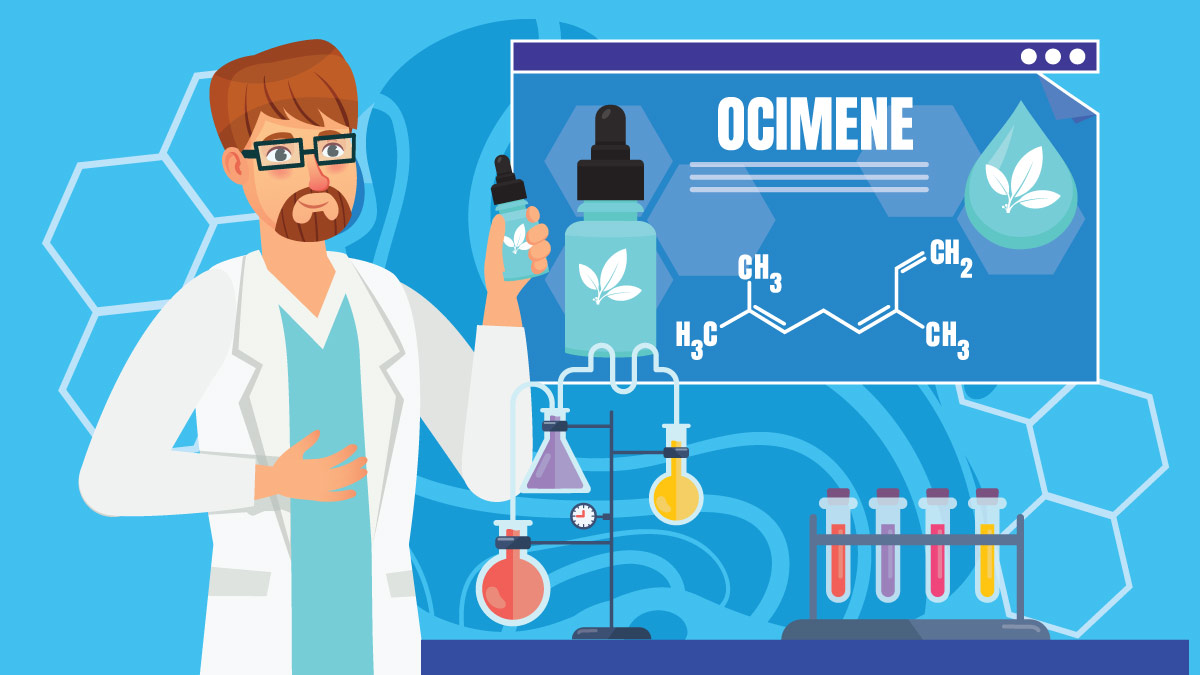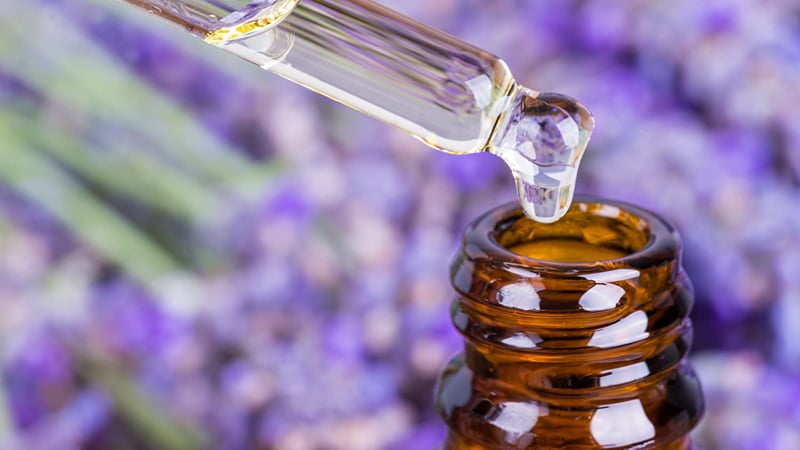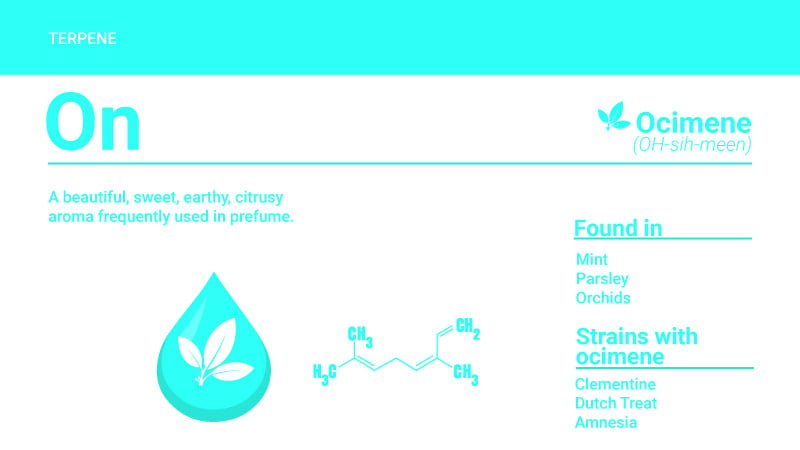Ocimene Terpene: Strains, Benefits & More

Ocimene is a terpene named for the Ocimum plant genus — which is the family that brings us herbs like basil and tulsi.
You’ll notice an immediate mint-like or menthol smell when you experience strains that possess higher levels of terpene ocimene.
Here’s everything you need to know about ocimene.
What Is Ocimene?
Ocimene helps plants protect themselves from invading insects. It’s especially abundant in basil, but you can also find it in cannabis, marjoram, allspice, tarragon, bay laurel, parsley, mint, mangoes, and more.
This terpene is also considered stimulating. You’re more likely to find it in plants with energizing effects.
For example, in cannabis, ocimene is more abundant in stimulating Sativa strains than it is in the more relaxing Indica varieties — but there are plenty of exceptions to this rule.
Related: What Are Terpenes?
What Does Ocimene Smell Like?
If you’ve ever smelled basil, you’ll be more or less familiar with how ocimene smells.
This terpene has an overall “woody” aroma with some notable minty and floral undertones. It may also feature a fruity or citrusy note.
The distinct scent makes it a valuable item to add to many cleaning products, as it masks the unappealing “chemically” scents inherent to many cleaning products.
How Do You Pronounce Ocimene?
Ocimene is pronounced “oh-seh-mean.”
What are the Effects of Ocimene?
Ocimene has shown a lot of potential as an antiviral and antifungal compound.
There isn’t a lot of information regarding the specific benefits of ocimene quite yet, especially on humans. At the moment, most of the research available on this terpene comes from animal studies and in vitro cell culture studies.
Here’s what we know so far:
Antiviral Qualities
Ocimene has been shown to inhibit several viruses. Some studies even suggest it binds better to viral cells than most other terpenes found in essential oils. The binding affinity of this terpene to certain kinds of viral particles is comparable with camphene and carvacrol.
Ocimene has been shown to neutralize various spike proteins that can cause viral infections to enter human cells. There have also been studies that suggest this terpene is effective in neutralizing the herpes simplex virus or HSV-1.
Antifungal Qualities
Studies have shown that ocimene may have antifungal properties.
A 2018 report states that higher concentrations of ocimene show greater results in inhibiting the growth of fungal infections.
Is Ocimene Safe?
Ocimene is considered safe when used properly. Concentrated terpenes of any kind can be harmful to the skin, lungs, or internal organs. Always wear gloves when working with terpenes and avoid getting them on your skin.
In order for ocimene to be safe, you need to dilute it down to around 5%. At this dose, ocimene is considered low risk.
Learn More: Are Terpenes Safe?
How to Use Ocimene?
Ocimene can be used in a variety of different forms, some of the most common being:
- Perfumes & Cosmetics — Ocimene is often used in perfumes due to its unique woody, minty, and floral aroma.
- Aromatherapy —Ocimen-containing essential oils are used in traditional aromatherapy for skin, metabolic disorders, or infections.
- Flavorings for vape oils — Ocimene is a distinct terpene in certain strains of marijuana. This terpene is often added with other terpenes to mimic the aroma of popular cannabis strains for vape oil flavorings.
Plants That Contain Ocimene
Ocimene is surprisingly common in nature.
There are too many species that produce this terpene to list, but here are some of the most common examples:
-
- Basil
- Tulsi
- Cannabis
- Peppermint
- Spearmint
- Chocolate mint
- Kumquats
- Mangos
- Tarragon
- Bay laurel
- Parsley
What Cannabis Strains Contain Ocimene?
Ocimene appears in many cannabis strains. This terpene is most common in Sativa strains high in THC, but you can also find it in hybrids and certain Indica varieties as well.
Ocimene is not common in hemp strains.
Cannabis strains high in ocimene include:
- Strawberry Shortcake
- Golden Pineapple
- Dream Queen
- Dutch Treat
- Green Crack
- Amnesia
- Holy Grail
Related: Which Terpenes Does Cannabis Produce?
Chemical Structure of Ocimene
There are two forms of ocimene — alpha and beta-ocimene. Both forms are acyclic monoterpenes closely related to myrcene.
As a monoterpene, ocimene is also related to borneol, camphene, citral, P-cymene, delta-3-carene, eucalyptol, fenchol, geraniol, geranyl-acetate, isopulegol, limonene, linalool, phellandrene, pinene, sabinene, terpineol, terpinolene, and many others.
In its pure form, ocimene has a clear or has a straw-yellow hue.
Ocimene Specs:
- IUPAC Name: 3,7-dimethylocta-1,3,6-triene
- Molecular Formula: C10H16
- Molecular Weight: 136.24
- Boiling Point: 212°F (100°C)
How to Use Ocimene
While ocimene is sometimes used in aromatherapy, you’ll have to be cautious when you’re using it, and you should always know what you are doing.
Ocimene has a lower boiling point than most other terpenes, at around 212°F/100°C.
Do not apply ocimene directly to your skin, and do not attempt to inhale it directly.
Ocimene is an irritant that can bother the skin, lungs, and eyes. You’ll need to dilute this terpene before it’s safe to use (as is true for all terpenes).
Learn More: How to Use Terpenes?
Key Takeaways: What is Ocimene?
Ocimene is a common terpene found in dozens of related and unrelated species of plants. Few species produce this compound in high amounts, with the exception of basil (Ocimum basilicum) — which the terpene is named after.
This terpene isn’t well studied, but preliminary research suggests it has potent antifungal and antiviral effects. It’s thought to be produced in plants as a deterrent for insects.
In cannabis, ocimene is most common in Sativa strains, but there are plenty of exceptions to this rule.
This woody, minty, and floral terpene is an excellent addition to cosmetics and vape products in need of a unique flavor modifier. We use this terpene in a lot of our blends to help round out the aroma of other terpenes in the formula.
References Cited
- Kulkarni, S. A., Nagarajan, S. K., Ramesh, V., Palaniyandi, V., Selvam, S. P., & Madhavan, T. (2020). Computational evaluation of major components from plant essential oils as potent inhibitors of SARS-CoV-2 spike protein. Journal of molecular structure, 1221, 128823. https://doi.org/10.1016/j.molstruc.2020.128823
- Ghaffari, H., Ataei-Pirkooh, A., Mirghazanfari, S. M., & Barati, M. (2021). Inhibition of herpes simplex virus type 1 infection by Sambucus ebulus extract in vitro. Medical journal of the Islamic Republic of Iran, 35, 9. https://doi.org/10.47176/mjiri.35.9
- Tanhaeian, A., Sekhavati, M.H. & Moghaddam, M. Antimicrobial activity of some plant essential oils and an antimicrobial-peptide against some clinically isolated pathogens. Chem. Biol. Technol. Agric.7, 13 (2020). https://doi.org/10.1186/s40538-020-00181-9
- Swingler, S., Gupta, A., Gibson, H., Heaselgrave, W., Kowalczuk, M., Adamus, G., & Radecka, I. (2021). The Mould War: Developing an Armamentarium against Fungal Pathogens Utilising Thymoquinone, Ocimene, and Miramistin within Bacterial Cellulose Matrices. Materials (Basel, Switzerland), 14(10), 2654. https://doi.org/10.3390/ma14102654
- Walde, S.G., Jyothirmayi, T., Rao, P.G.P., Shivaswamy, R. and Srinivas, P. (2005), Flavour volatiles of leaves, fruits and seed cotyledons of Murraya koenigii L.. Flavour Fragr. J., 20: 169-172. https://doi.org/10.1002/ffj.1436
- Shafaroodi H, Roozbahani S, Asgarpanah J. The essential oil from Ferulago angulata (Schltdl.) Boiss. fruits exerting potent analgesic and anti-inflammatory effects. Journal of Physiology and Pharmacology : an Official Journal of the Polish Physiological Society. 2021 Feb;72(1). DOI: 10.26402/jpp.2021.1.08. PMID: 34099587.
- Motte.Sushma, M., Lahari.Sidde, L., & Bandi.Jayanthi, B. (2020). Extraction of Kapura Tulasi(Ocimum kilimandscharicum) leaves: Phytochemical studies and Anti- diabetic activity of the Ethanolic Extracts. World Journal of Current Medical and Pharmaceutical Research, 2(3), 237-245. https://doi.org/10.37022/wjcmpr.vi.141
- Barnali Ghatak, Sk Babar Ali, Bipan Tudu, Panchanan Pramanik, Soumyo Mukherji, Rajib Bandyopadhyay, Detecting Ocimene in mango using mustard oil based quartz crystal microbalance sensor, Sensors and Actuators B: Chemical, Volume 284, 2019, Pages 514-524, ISSN 0925-4005, https://doi.org/10.1016/j.snb.2018.12.156.



